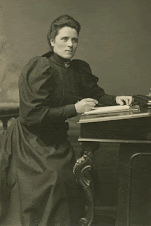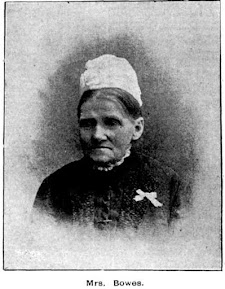A true "Lady"
Last Sunday was Mother's Day here in Australia and many other countries throughout the world. Today's blog is of a long forgotten woman, technically not a mother but who displayed the qualities we all admire in the definition of the word and proved to be a wonderful step mother to the young children of her deceased husband.
LADY JULIA PARKES
Julia Lynch, an Irish lass, was born in Country Cavan in 1871, one of five children to Terence, a farmer, and his wife Margaret, and brought up in the Catholic religion.
The family departed Ireland in 1888 and arrived in Brisbane aboard the "Jumna" on 13 October 1888. Julia made her way to Sydney around 1889 and was employed in the household of Cardinal Patrick Moran, the Catholic Archbishop of Sydney. It is said that Sir Henry Parkes was a guest at a dinner given by the Cardinal where she was waiting at table. Soon after she was employed as a maid at Kenilworth, his home, one the Gothic "witches houses" located in Johnston Street, Annandale.
Lady Julia Parkes - from National Library archives
Henry Parkes rose from being a young man of little formal education from Warwickshire, England, to being known as the "Father of Federation" in Australia. After he arrived with his first wife in 1839, he worked for the Customs Department and showed a keen interest in colonial politics. He claimed that his early evangelical education was the inspiration for his great oratorical speeches.
He soon became a politician and the longest non-consecutive Premier of the Colony of New South Wales, the present-day state of New South Wales in Australia. He earned his title as the "Father of Federation" due to his early promotion for the federation of the six colonies of Australia, as an early critic of British convict transportation and due to his proposal for the expansion of the Australian continental rail network. Parkes delivered his famous Tenterfield Oration in 1889 which led to his instigation of a conference in 1890 and a Constitutional Convention in 1891, the first of a series of meetings that led to the federation of Australia. He was knighted in 1877.
Henry's first wife, Clarinda, bore twelve children, five dying in infancy. When she died in 1888, Henry had already fathered three children by Eleanor Dixon, who soon became his second wife. This marriage was seen as quite controversial as Henry was over thirty years older than Eleanor.
It was into this household that Julia Lynch entered in about 1890, becoming a companion to Lady Eleanor Parkes. Eleanor was a quiet, unassuming person who took a keen interest in social and welfare interests but was rarely seen at public functions. She was quite ill and died of cancer in July 1895.
So it was that Julia Lynch became the third wife of Henry Parkes and therefore the title of "Lady" when they married in a quiet ceremony at St Patrick's Cathedral in Parramatta on 24th October 1895, some three months after Eleanor's death. She was 23 and Henry was 81.
Rumours abounded that Eleanor had implored Julia to marry Henry to be his companion as he wouldn't live past three months and yet another rumour stated that if he remained a widower he would lose a substantional sum of money.
Newspaper reports of the day state that "the third Lady Parkes is tall in stature, probably about 5ft. 4in. (??), and of fine figure, with a pleasant homely face, bright blue eyes, with dark nut-brown hair. Intimate friends describe her as being wonderfully healthy, and possessing all the physical qualities and disposition of a a lady, well-educated, mild-mannered, with none of the predilections of the ordinary domestic."
Lady Julia Parkes with Sir Henry - courtesy of The Glebe Society
After the wedding the governess and other staff resigned. Sir Henry hired a new servant who had previously worked for Cardinal Moran. "Old Polly" who had been in service with the family since she was seventeen, remained. At the time of this marriage Sir Henry was the father of twelve mostly adult children from his first marriage and five from his second. His daughters, Annie and Lily, who had swept out of the family home in disapproval of his second marriage to a woman thirty plus years his junior, were even more disgusted by this union. They had moved into Kenilworth after Eleanor's death but left before the newlyweds returned home.
"Kenilworth" - Annandale - courtesty Project Guttenburg
Six months after his third marriage, Henry caught pneumonia and died on 27th April 1896, penniless and in debt. Julia, who had nursed him, was reported to be in a state of near collapse, destitute and burdened with the extra responsibility of caring for his five youngest children who ranged in age from three to twelve years. Refusing a State Funeral, because Henry had wanted a private affair, she attended his burial with his first wife at Faulconbridge in the Blue Mountains west of Sydney.
Kenilworth had to be vacated and the contents sold to pay creditors. On the 18th July 1896, the Parkes Family Grant Act was passed by the Legislative Assembly, under the leadership of Henry's old nemesis, George Reid. Julia Parkes was allowed annual payments of £100 and £80 for each of the children while they were minors, their progress to be monitored by the Governor.
Advised to look for alternate accommodation, Julia settled in Glebe. After buying new furniture, she rented a newly built brick cottage in Allen Street opposite a large paddock. The rent on "Auburn" was £75 p.a. swallowing up 75% of Julia's personal allowance which had also to pay for the upkeep of the household. "Old Polly" and the new servant, the five children, plus Charlie, Eleanor's son from an earlier relationship, all moved in. When life settled down Julia moved the family to nearby accommodation seeking a larger garden for the children.
Julia devoted herself to the task of bringing up five children and her obituary in the Herald states "it is well known how faithfully she discharged her trust".
Lady Parkes never re-married and whilst being cared for by the Little Company of Mary she died aged forty six at Lewisham Hospital on 11 July 1919.
Her youngest stepson, Cobden Parkes, became an Architect, Public Servant and Soldier. He rose to become the Government Architect in 1935, the first to be fully trained within the office and retired in 1958.
A tough, brave woman, who worked throughout the gossip of the day to become a well respected member of society and a great step mother.
Lady Julia Parkes grave - personal collection
Julia rests peacefully in the newer Catholic section, M2, section 3.
# with thanks to The Glebe Society; Ancestry.com and the Australian Dictionary of Biography







Wow, selfless lady! Enjoyed the read. Thank you!
ReplyDeleteYou are welcome and yes a selfless woman!
Delete